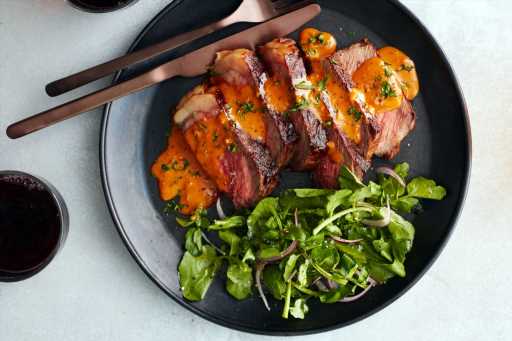Steak Diane and more weeknight recipes to make this week
By Emily Weinstein, The New York Times
I sort of love Valentine’s Day and harbor no cynicism toward it: It’s one of the few days on the calendar devoted to being sweet to others. I know this makes me corny, and I simply do not care. The handmade card on construction paper, the freshly baked brownies, the bowl of spaghetti carbonara — adorable.
I regret to tell you I have no feelings whatsoever about the Super Bowl, though I fondly remember the glory I felt the one time I turned up at a friend’s apartment for the game with all the makings of an epic tray of nachos. (Super Bowl Sunday is also one of the best nights of the year to dine out in New York. You can walk into nearly any restaurant without a reservation.)
1. Steak Diane
A classic recipe, steak Diane dates to the 1930s, when it was prepared tableside at restaurants with much fanfare. The piquant sauce, a mix of cream, cognac, shallots and Worcestershire, is speedy and simple to make from the steak’s pan drippings. Flambéing the cognac adds drama, but you can skip that step, and just let the cognac simmer for 2 minutes to cook off some of the alcohol. Use any cut of steak you like. Even chicken breasts or pork tenderloins will work in the heady, creamy sauce. Serve with a simple salad alongside, if you like.
By Melissa Clark
Yield: 2 servings
Total time: 15 minutes, plus 15 to 30 minutes’ resting
Ingredients
- Salt and freshly ground black pepper
- 1 (12- to 16-ounce) boneless steak, such as filet mignon or strip steak, about 1-inch thick
- 2 tablespoons unsalted butter
- 1 tablespoon neutral oil, such as grapeseed or safflower
- 2 tablespoons minced shallot or red onion
- 1 teaspoon tomato paste
- 2 tablespoons cognac or brandy
- 1/4 cup heavy cream
- 1 teaspoon Dijon mustard
- 1 teaspoon Worcestershire sauce
- 1/2 teaspoon fish sauce (optional)
- Minced chives or parsley, for garnish
Preparation
1. Sprinkle salt and pepper on both sides of the steak and set aside at room temperature for 15 to 30 minutes.
2. Melt the butter and heat the oil in a large skillet set over medium-high. Pat the steak dry with a paper towel. Increase the heat to high, add the steak to the pan and sear until well browned, about 2 minutes. Turn and sear on the other side and cook until done to taste, 1 to 4 minutes longer. If your steak is thick enough, insert an instant-read thermometer in the center to test the temperature: Rare is 125 degrees; medium-rare is 135 degrees; medium is 145 degrees. When the steak is done, move it to a cutting board and tent with an overturned bowl or foil to keep warm.
3. Add shallot to the pan and sauté until golden, 2 to 3 minutes on medium-high heat, stirring once or twice. Stir in the tomato paste, mixing well and letting it deepen in color, about 1 minute.
4. Turn off the heat and add the cognac to deglaze the pan. Using a long match or stick lighter, set the cognac on fire, standing back and taking care. Let the flames burn out, then turn the heat to medium-high and cook until the cognac is almost evaporated, 1 to 2 minutes.
5. Stir in the cream, mustard, Worcestershire and fish sauce, if using, and cook until thickened, about 1 to 2 minutes. Drizzle the warm sauce over the steak — you can slice beforehand if you wish — and garnish with black pepper and herbs.
2. Gochugaru Salmon With Crispy Rice
Gochugaru, a mild, fragrant red-pepper powder, bedazzles this quick salmon dinner. As a key ingredient in Korean home cooking, gochugaru proves that some chiles provide not only heat but fruity sweetness as well. Here, that’s especially true once it’s bloomed in maple syrup, vinegar and butter. If you like shiny things, you may find great pleasure in watching this pan sauce transform into a mirrored, crimson glaze. Try to get long center-cut salmon fillets for uniform thickness and even cooking. Their crispy skin tastes wonderful with white rice, which toasts in the rendered salmon fat. To balance the richness of the fish, serve it with fresh, crunchy things, like cucumbers or pickles, or a big green salad.
By Eric Kim
Yield: 4 servings
Total time: 20 minutes
Ingredients
- 4 skin-on salmon fillets (6 ounces each)
- Kosher salt (such as Diamond Crystal) and black pepper
- 1 tablespoon olive oil
- 4 cups cooked white rice, preferably leftovers
- 4 teaspoons gochugaru (see tip)
- 2 tablespoons maple syrup
- 2 tablespoons rice vinegar
- 2 tablespoons cold, unsalted butter, kept whole
- Sliced cucumbers or pickles, for serving (optional)
Preparation
1. Season the salmon on all sides with salt and pepper. Heat a large cast-iron or nonstick skillet over medium-high. Add the olive oil and sear the salmon fillets skin side down until the skin is browned and crispy, 2 to 5 minutes. The salmon’s orange flesh will begin to turn pale coral as the heat slowly creeps up the sides of the fish; you want that coral color to come up about two-thirds of the way at this point for a nice medium-rare. Carefully flip the salmon and cook the second side until the flesh feels firm, another 1 to 2 minutes. When you press it, it should not feel wobbly. Transfer the salmon to a plate skin side down and keep the pan with the rendered fat over the heat.
2. Add the rice to the fat in the pan and spread in an even layer, packing it down as if making a rice pancake. Reduce the heat to medium and cook until the bottom is lightly browned and toasted, about 5 minutes. You should hear it crackle. Flip the rice like a pancake, using a spatula if needed. You may not be able to flip it all in one piece, but that’s OK. Cook until lightly toasted on the second side, another 1 to 2 minutes. Go longer if you want crispier rice, but the trifecta of crispy-chewy-soft tastes wonderful.
3. While the rice is cooking, stir together the gochugaru, maple syrup, rice vinegar and 1 teaspoon salt in a small bowl. When the rice is done, divide it evenly among the plates. In the now-empty pan, add the gochugaru mixture and cook, stirring constantly, over medium-high heat until it bubbles up and reduces significantly, 15 seconds to 1 minute. It should look pretty sticky. Turn off the heat and add the cold butter, stirring with a wooden spoon or tongs until fully melted and incorporated into the gochugaru mixture. Pour this glaze over the salmon and serve with cucumbers or pickles, if you’d like.
TIP: You can find gochugaru, or red-pepper powder, at Korean or Asian supermarkets and at most grocery stores, as well as online. It sometimes comes in larger bags, which is not a problem because it freezes beautifully and tastes great dusted over just about anything.
3. Creamy Pan-Roasted Scallops With Fresh Tomatoes
In this homage to a classic dish at Grand Central Oyster Bar in New York, scallops are quickly poached in a creamy, piquant tomato sauce that’s spiked with Worcestershire and celery seed. If you want to work a little ahead, you can make the sauce through Step 2, and leave it in the pan, covered for an hour or two. Reheat it before adding the scallops in Step 3. Then serve the scallops right away, with some bread or rice to soak up every last drop of the herby, savory sauce.
By Melissa Clark
Yield: 4 servings
Total time: 40 minutes
Ingredients
- 2 tablespoons unsalted butter
- 1/4 cup thinly sliced shallots or red onion
- Pinch of celery seeds
- Salt and black pepper
- 2 cups chopped fresh tomatoes
- 2/3 cup dry white vermouth, dry white wine or clam juice
- 4 teaspoons Worcestershire sauce
- 1 cup heavy cream
- 2 pounds sea scallops, patted dry
- 1/2 cup chopped fresh chives, plus more for garnish
- 1/2 cup chopped celery leaves or parsley leaves, or a combination, plus more for garnish
Preparation
1. Heat a large skillet over medium-high and add the butter, letting it melt. Add shallots, celery seeds and a pinch each salt and pepper, and cook until the shallots are tender and opaque, about 3 to 5 minutes. Stir in tomatoes. Bring to a simmer, stirring occasionally, and cook until jammy, 9 to 13 minutes.
2. Increase heat to medium-high and stir in vermouth. Cook until about a third of the liquid evaporates, about 5 minutes. Add Worcestershire and cream, and simmer, reducing heat if needed and stirring occasionally, until sauce thickens enough to coat a spoon, 5 to 7 minutes.
3. Season scallops with salt and pepper, and add to the pan. Cook, uncovered, until scallops are just cooked through and opaque, 3 to 6 minutes, depending on the size of the scallops. Stir in chives and celery leaves. Serve immediately, garnished with more chives and celery leaves.
4. Spaghetti and Drop Meatballs With Tomato Sauce
This fast version of spaghetti and meatballs with red gravy is ready in less than 30 minutes, but you’ll be chopping, stirring and monitoring heat — actively working — from start to finish. You’ll be busy, but not frantic, and rewarded not only with the twirling of pasta in half an hour, but with the satisfaction that you made every second count.
By Mark Bittman
Yield: 4 servings
Total time: 25 minutes
Ingredients
- Salt
- 2 tablespoons olive oil
- 12 ounces ground beef
- 6 ounces Parmesan, or about 1 1/2 cups
- 1 bunch fresh parsley
- 1/4 cup breadcrumbs
- 1 egg
- Black pepper
- 1 large onion
- 3 garlic cloves
- 6 cups canned crushed tomatoes (a little less than two 28-ounce cans)
- 3 bay leaves
- 1 pound spaghetti
Preparation
1. Bring a stockpot of water to a boil and salt it. Put the olive oil in a large skillet over medium heat.
2. Put the ground beef in a medium bowl. Grate the cheese, put 1 cup over the meat and reserve the rest, about 1/2 cup. Chop 1/2 cup of parsley and add all but 2 tablespoons to the meat mixture; save the rest of the parsley for another use. Add the breadcrumbs, crack in the egg, and sprinkle with salt and pepper. Gently mix until everything is just combined.
3. Raise the heat to medium-high; use 2 teaspoons to drop rounds of the meatball mixture into the skillet without touching one another if you can help it. Adjust the heat so the meatballs sizzle but don’t burn and cook undisturbed until they’re lightly browned on the bottom, 5 to 6 minutes.
4. Meanwhile, trim, peel and chop the onion; scatter it around the meatballs. Peel and mince the garlic and put it on top of the onions.
5. When the meatballs are browned on the bottom and the aromatics begin to soften, add the tomatoes to the skillet, along with the bay leaves and a sprinkle of salt and pepper. Adjust the heat so the mixture bubbles gently but steadily, then cover the skillet and cook until the meat cooks through, about 8 minutes. Remove the lid and let the sauce bubble vigorously to thicken for another 5 to 10 minutes, essentially while the pasta cooks. Stir only as needed and carefully if you do.
6. Add the pasta to the boiling water and stir. Start tasting after 5 minutes. When the pasta is tender but not mushy, drain it, reserving some cooking water. Return the pasta to the pot.
7. Move the meatballs to one side of the skillet with a spatula and stir the sauce; taste and adjust the seasoning. Discard the bay leaves and spoon about half the sauce into the pasta pot. Toss the pasta over low heat, adding a splash of cooking water to make it saucier if you like.
8. To serve, divide the pasta among 4 plates or bowls; top with the meatballs and the remaining sauce, and sprinkle the remaining Parmesan and parsley over the top.
5. Winter Squash and Wild Mushroom Curry
This is comfort food, Indian-style. It’s also vegan, and perfect for a fall evening. Use a mixture of cultivated mushrooms; they come in all shapes and sizes. Look for royal trumpets, a large, meaty type of oyster mushroom; shiitakes, and small portobellos. Use some wild mushrooms too, if you can, like golden chanterelles, lobster or hen of the woods. You can make this as spicy as you wish, but be sure to include some cayenne and green chile, to complement and play off the creamy coconut milk sauce. Serve with basmati rice, rice noodles or mashed potatoes.
Recipe from Madhur Jaffrey
Adapted by David Tanis
Yield: 4 servings
Total time: 25 minutes
Ingredients
- Salt
- 2 tablespoons olive oil
- 12 ounces ground beef
- 6 ounces Parmesan, or about 1 1/2 cups
- 1 bunch fresh parsley
- 1/4 cup breadcrumbs
- 1 egg
- Black pepper
- 1 large onion
- 3 garlic cloves
- 6 cups canned crushed tomatoes (a little less than two 28-ounce cans)
- 3 bay leaves
- 1 pound spaghetti
Preparation
1. Bring a stockpot of water to a boil and salt it. Put the olive oil in a large skillet over medium heat.
2. Put the ground beef in a medium bowl. Grate the cheese, put 1 cup over the meat and reserve the rest, about 1/2 cup. Chop 1/2 cup of parsley and add all but 2 tablespoons to the meat mixture; save the rest of the parsley for another use. Add the breadcrumbs, crack in the egg, and sprinkle with salt and pepper. Gently mix until everything is just combined.
3. Raise the heat to medium-high; use 2 teaspoons to drop rounds of the meatball mixture into the skillet without touching one another if you can help it. Adjust the heat so the meatballs sizzle but don’t burn and cook undisturbed until they’re lightly browned on the bottom, 5 to 6 minutes.
4. Meanwhile, trim, peel and chop the onion; scatter it around the meatballs. Peel and mince the garlic and put it on top of the onions.
5. When the meatballs are browned on the bottom and the aromatics begin to soften, add the tomatoes to the skillet, along with the bay leaves and a sprinkle of salt and pepper. Adjust the heat so the mixture bubbles gently but steadily, then cover the skillet and cook until the meat cooks through, about 8 minutes. Remove the lid and let the sauce bubble vigorously to thicken for another 5 to 10 minutes, essentially while the pasta cooks. Stir only as needed and carefully if you do.
6. Add the pasta to the boiling water and stir. Start tasting after 5 minutes. When the pasta is tender but not mushy, drain it, reserving some cooking water. Return the pasta to the pot.
7. Move the meatballs to one side of the skillet with a spatula and stir the sauce; taste and adjust the seasoning. Discard the bay leaves and spoon about half the sauce into the pasta pot. Toss the pasta over low heat, adding a splash of cooking water to make it saucier if you like.
8. To serve, divide the pasta among 4 plates or bowls; top with the meatballs and the remaining sauce, and sprinkle the remaining Parmesan and parsley over the top.
This article originally appeared in The New York Times.
Subscribe to our weekly newsletter, In The Know, to get entertainment news sent straight to your inbox.
Source: Read Full Article





